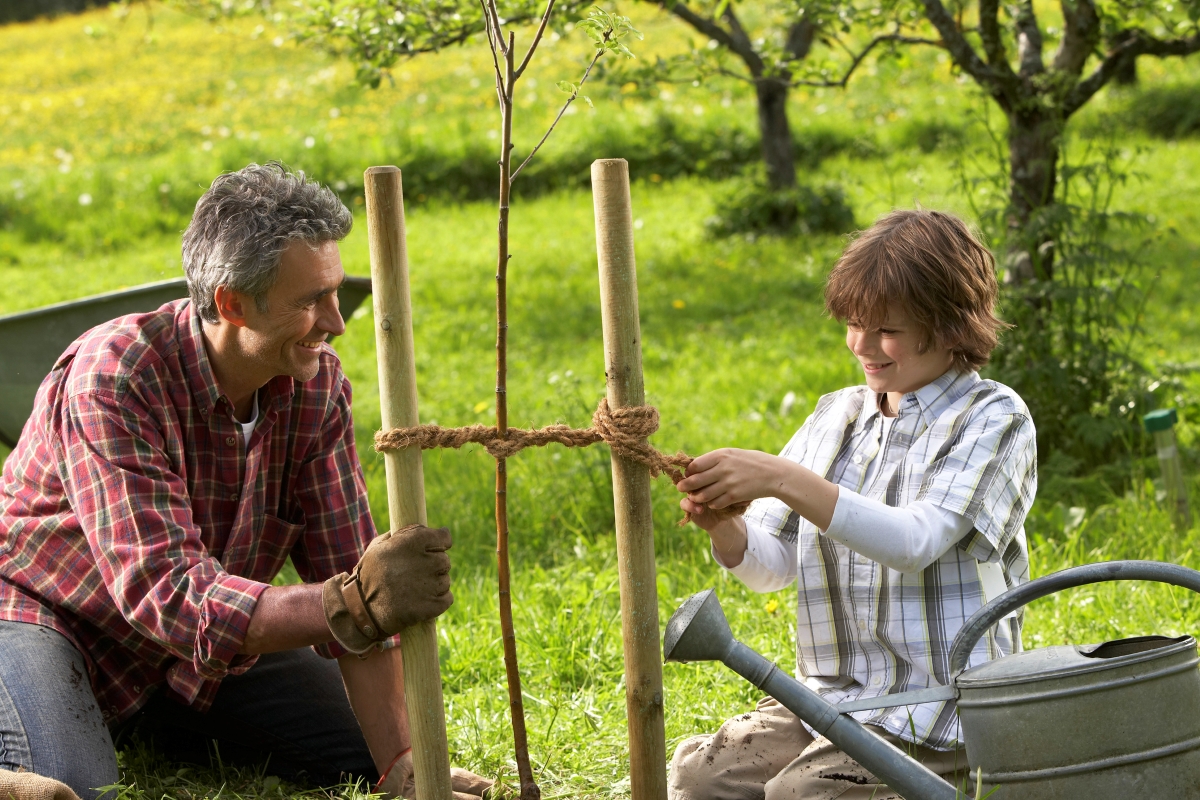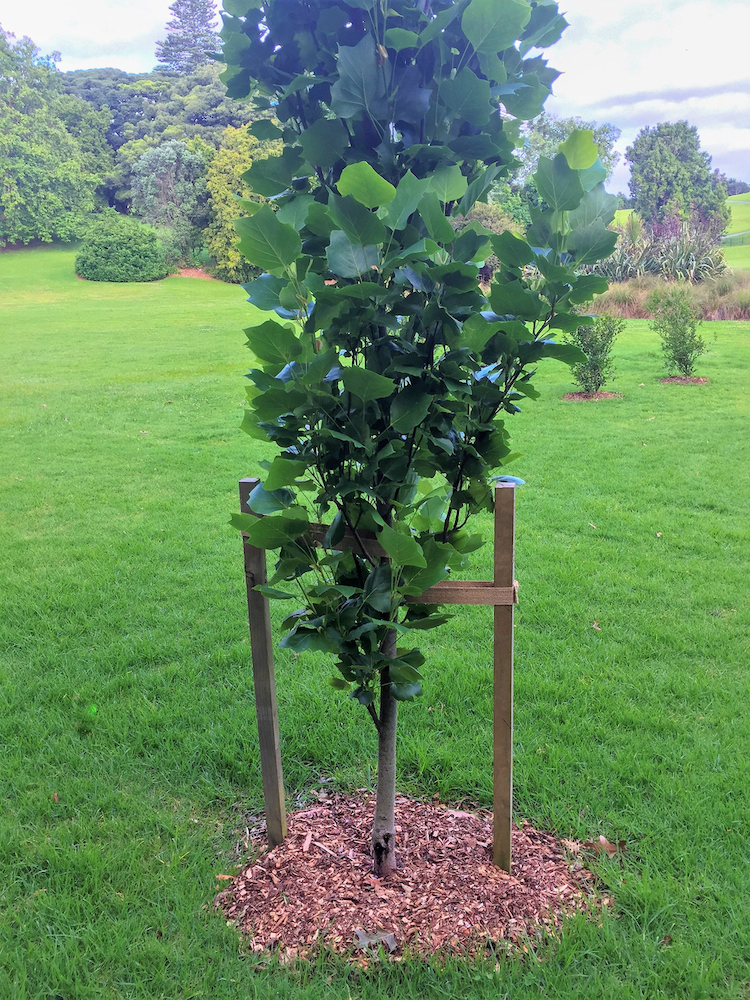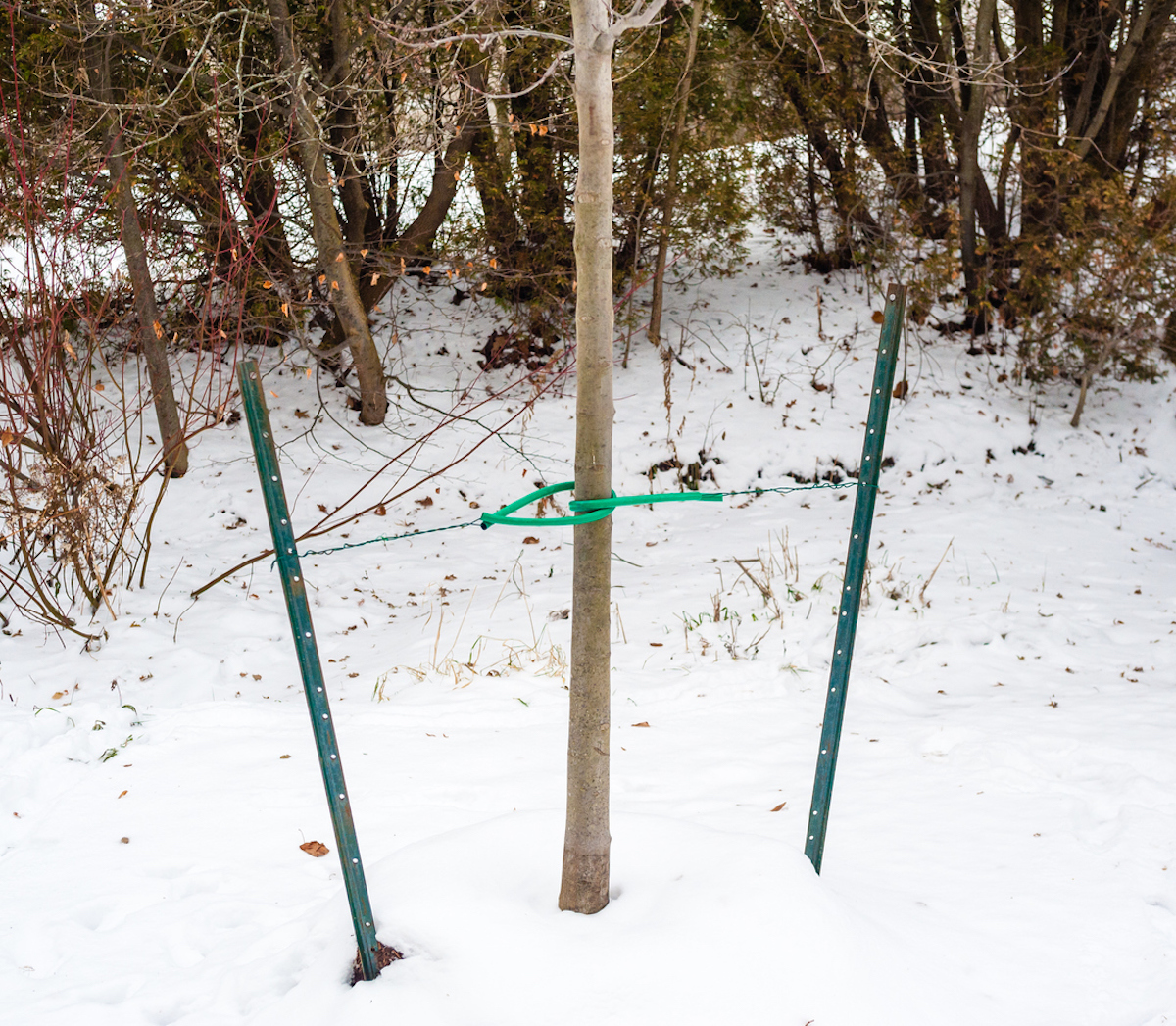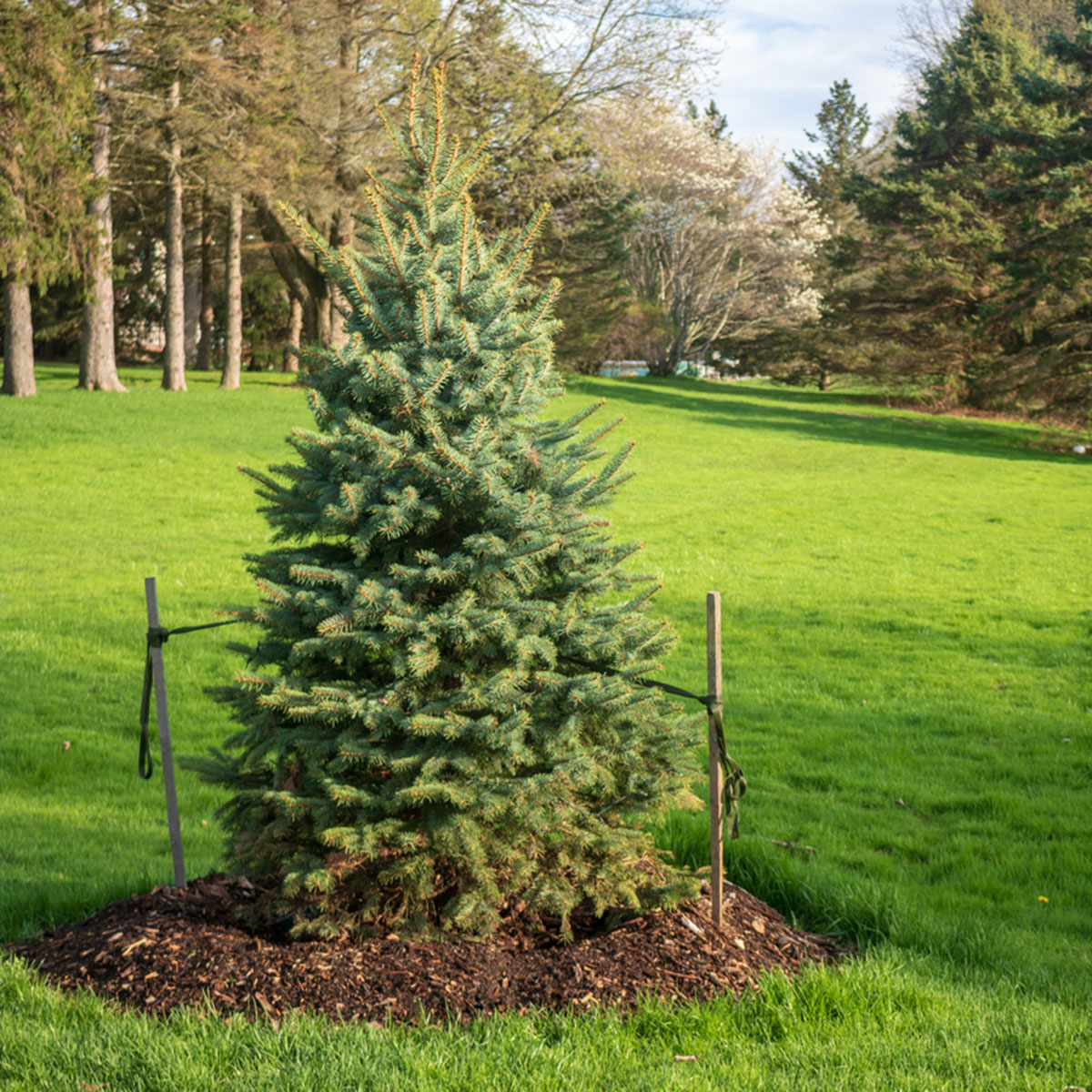

We may earn revenue from the products available on this page and participate in affiliate programs. Learn More ›
Many new trees do just fine on their own. In fact, the movement they experience from normal wind and weather helps trees develop strong root systems and solid trunk girth. But new trees in open areas often require staking early in their lives. Tree staking anchors young trees and supports them while they begin to grow.
Staking a tree “prevents leaning while the tree is being established,” says Gary Schermerhorn, arborist and a district manager for the Davey Tree Expert Company in King of Prussia, Pennsylvania. However, proper staking technique and materials are essential. If a tree does not need staking or is not staked properly, the effort can backfire and do more harm than good.
Benefits of Staking Trees
Though most new trees planted in protected areas do not need help, there are several scenarios in which it’s beneficial—even necessary—to stake a tree during its first growing season. For those that need help, tree staking provides several key benefits. Chief among these is preventing leaning of a tree, often in the direction of the prevailing wind in the open area where it’s planted.
In addition, the tree might need help becoming established as the trunk and roots grow. If the tree is subjected to too much wind or excessive foot traffic, the root ball can move around in the soil, which can damage the roots. Staking helps prevent this, and lowers risk of root damage or even uprooting a tree. Finally, stakes around a tree offer a barrier of sorts near the base of the tree, helping to sway people, pets, and lawn mowers away from a young trunk.
When Does a Tree Require Staking?

Although many new trees do not need staking, some young trees planted in the open benefit from help to get started. In particular, the following tree types and situations can call for staking:
- Those planted in strong and prevailing wind conditions or slopes—wind might blow a young tree right out of the ground or break its main trunk
- New trees establishing roots in sandy soil and in the open are more likely to need staking
- Certain tree varieties that are more vulnerable to wind damage, such as eucalyptus, oleander, hibiscus, mesquite hybrids, and acacia trees
- Bare-root trees or trees with small root balls as their roots take hold and grow
- Trees planted in areas with lots of foot traffic
- Young trees planted in areas with enough rainfall to cause overly wet soil
- Top-heavy trees with no lower branches
- A new tree that does not stand up well on its own or begins to lean after planting

Tried-and-True Advice
“While wind is often a concern for young trees, in my experience the most common reason trees lean is because they have not been properly planted. Not only does the hole need to be as deep as the rootball, it needs to be at least three times as wide. This is why you should till the soil in a wide circumference around the tree—the Arbor Day Foundation recommends as wide as five times the width of the root ball. This tilled soil will be used to compact around the tree when you plant it to firmly hold it in place.”
—Amber Guetebier, Contributing Writer
How Long Should a Tree Be Staked?
“Generally, if the tree appears to be anchored and steady, the stakes should be removed before the next growing season,” says Jason Parker, district manager of the Davey Tree Expert Company, in Horsham, Pennsylvania. It usually takes a full growing season for a tree to develop sturdy roots. So, if properly staked in spring, remove the stakes in fall “if the tree feels supported and can stand on its own,” he says, though in some circumstances, trees need to be staked longer, even as long as a year. If the tree is large, still shows signs of unsteadiness, leans, or appears weak, leave the stakes on a little longer.
“Typically, though, it’s recommended not to stake past 6 months so the tree can develop some strength and grow supporting wood,” says Parker, “If it’s staked for too long, it may become reliant on the stakes for support and may struggle to support itself once the stakes are removed,” he says. In the end, a tree that is staked for too long has a weaker trunk and less-developed root system than it should.
Avoid staking any tree and forgetting about it, since the materials used to support the tree can damage it if left on too long. Wires, in particular, can girdle and damage a trunk, and are not recommended.
How To Stake a Tree in 4 Steps

The best way to stake a tree is with purchased tree stakes and straps, or you can make your own. These steps apply to small trees—those that have trunks that are 1.25 to 4 inches around and heights of 8 to 14 feet. Most ball, burlap, and container-grown transplants fall in this size range and do well with just staking, versus other tree-stabilization methods.
Guying is similar to staking, but ties trees to several shorter tree anchors. Larger trees also might need ground anchors, steel cable, and lag hooks, Schermerhorn adds. It might be best to call in an arborist to secure larger trees.
Tools & Materials
Bobvila.com may earn a commission from purchases made through these links.
Step 1: Gather stakes and straps.
For small trees (those with less than 3-inch diameter trunks), you can get by with one 5- or 6-foot tree stake. Larger trees require two or three stakes, depending on the tree’s size, force of wind exposure, and whether the tree is leaning. Metal stakes have tapered bottoms and are a little stronger than treated wooden ones, and should be sufficient for trees no taller than 10 or 12 feet. To DIY your own stakes, taper the ends of 6-foot-long, 2×2 pieces of lumber.
The best bet for strapping is to purchase tree support straps, which are designed specifically for staking trees. “Broad, strong strapping, such as ArborTie, works fine,” says Schermerhorn. Flat straps provide a large surface area to distribute pressure and avoid damage to the trunk.
Many DIYers use a rope covered with a repurposed piece of rubber hose or rubber inner tube for a flexible and soft wrap on tree trunks. Other options are old hosiery or yoga-pant legs; the key is that the material is both wide, smooth, and flexible. “Canvas strapping or biodegradable strapping material” are great options for DIYers staking a tree, says Parker.
“Whatever you do, do not use wire as a strapping material,” says Parker. Wire cuts into the tree and can cut off the flow of water and nutrients.
Step 2: Drive the tree stakes.
Tree stakes should only go on the outer edge (or slightly outside of) the transplant hole or known location of the tree’s root ball, typically about 15 to 18 inches from the trunk. There is no need to go outside of the mulched planting area around the tree when supporting a tree with stakes. Place the stake on the windward side, which is upwind from the direction of prevailing winds.
For staking a small tree, drive the stake into the ground with a heavy-duty hammer, mallet, or sledgehammer, depending on the ground hardness and resistance. Drive stakes in about 18 inches deep to secure them, leaving enough height above the ground (usually about 3 to 5 feet).
If adding a second stake, place it opposite the first. When using three stakes because of concerns about skinny trees in wind, place the stakes in a triangle around the tree, beginning with the stake on the windward side.
Step 3: Tie the support straps.

In general, wrap the straps around the trunk about one-half to two-thirds of the distance from the ground to the first set of branches. You can check this positioning by gently wiggling the planted tree with your hand at that height and making sure it feels supported. Tie the strap in a solid double knot around the stake or loop rope through the grommets on the tree straps if available.
“The ties should never be taut on the tree,” says Parker. “They should be just tight enough to support the tree, while still having some drooping in the line,” he says. This allows the tree some gentle movement and helps prevent damage to the trunk. Be especially cautious if using homemade wire-in-hose straps: Stretch them too tight and they’ll injure the sensitive tissues just under the bark.
It’s a good idea to check the tree a few times as it grows that first year, and adjust the ties or straps if they have become too taut. Likewise, Parker says that wind and weather can cause some shifting of the tree and ties, “so it is also helpful to check on them after storms and during regular tree checks,” he says.
Step 4: Untie or check tree sturdiness after the first growing season.
Remember, you should only stake a young tree for one growing season, until the root system has had a chance to spread out and set in. After removing the straps, you can leave the stakes in the ground as protection from foot traffic and lawn equipment if they don’t pose a hazard.
If you choose to remove the stakes, dig gently around the base of each one to loosen it, being careful not to disturb the roots. Keep your straps and stakes if they are still in good condition to be used for the next tree you plant that requires staking.
Final Thoughts
Most DIYers can learn how to stake a tree with the tips above, such as selecting wide material that will not rub against and damage the trunk; driving the stakes far enough away from the root ball to prevent damage; and tying the strap with a little give. If a tree is large or mature and already damaged, it might be best to call in a professional arborist. According to Parker, “securing large trees in areas prone to hurricanes and heavy rain involves more robust methods than standard tree staking, such as cabin, bracing, and ground anchoring systems.” Leave these jobs to pros as well.
FAQs
Causes of leaning trees vary, and might affect whether staking will help. The best solution is to stake a young tree after planting to help prevent leaning caused by wind. Weather events can damage trees. A tree also might lean because the root ball shifted in the ground, which might involve some underground intervention that staking can’t repair.
Try to determine when your tree started leaning and whether it is exposed to wind, then stake properly and temporarily. If a storm causes the leaning, try to address it and stake as soon as possible after the storm has subsided.
The trick to helping stabilize a tree that is top heavy or very tall and thin is to protect the trunk while helping to keep the root ball steady underground. Use of three stakes gives the skinny tree the most support, as long as each strap or guide wire is not too tight or too loose and that you properly protect the trunk from rubbing or girdling.
Wind actually helps trees, but sometimes too much of a good thing requires supporting a young or leaning tree. Follow these tips:
• When staking the tree, support it, but don’t pull the ties too tightly. The tree needs some flexibility and movement to grow strong.
• It is best to use at least two stakes. In high-wind areas, place them perpendicular to the prevailing wind.
• Place the ties or straps around the tree trunk so they are no higher than two-thirds of the tree’s height.
• Large evergreen trees have higher wind resistance, and the support is designed to prevent the tree from tipping over in strong winds.
Remember that some sway or movement gives the new tree a workout. Avoid tightening the straps or wires so tight that the tree can’t budge. A strong wind might cause the trunk to snap where the guides attach. Make sure the ties are flexible but tight enough to keep the tree from blowing over completely.
You can gently straighten the trunk of a tree that leans so badly that it affects the tree’s growth. If possible, use guy wires and wooden or metal stakes to brace the tree, driving stakes deep enough to hold, but making sure they are tall enough to wrap the ties or guides a little more than halfway up the trunk. Have a helper push the trunk upright carefully before tightening the straps. Leave the stakes in place for a year before assessing whether the staking can be removed.
